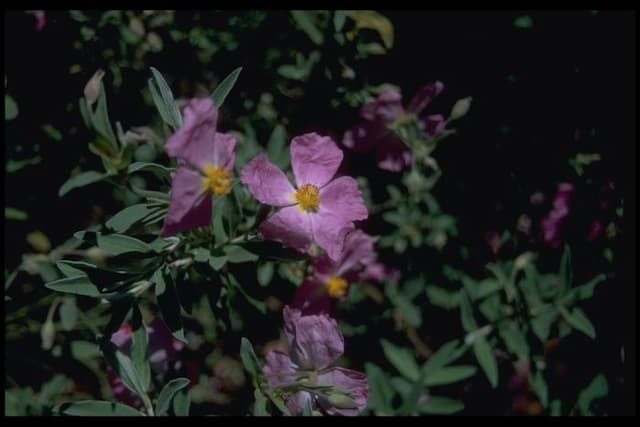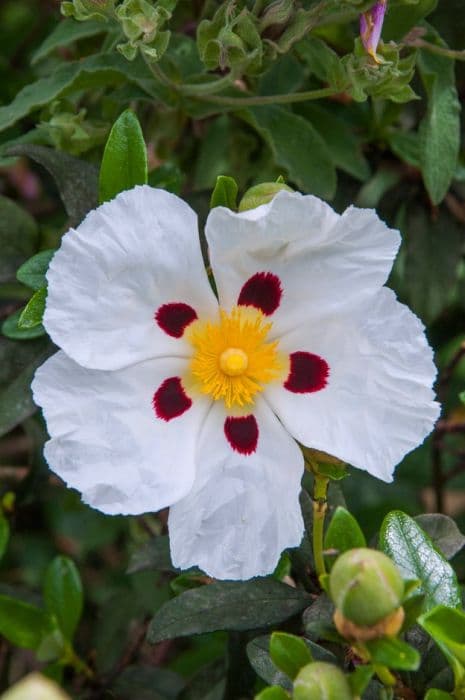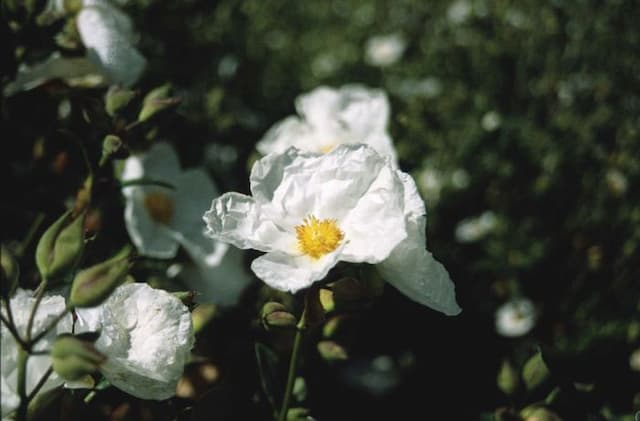Orchid Rockrose Cistus × aguilarii 'Maculatus'

ABOUT
The Cistus × aguilarii 'Maculatus', commonly known as Rock Rose, is a visually striking plant characterized by its showy flowers and lush foliage. The flowers are large and have a classic single blossom shape with five petals, radiating a soft, satiny sheen. Each petal is predominantly white, which serves as a canvas for a prominent burgundy spot at the base, giving the appearance of a "stained" or "spotted" texture that adds a dramatic flair to the flower display. Surrounding these eye-catching flowers, the foliage presents as a dark green, providing a rich contrast that makes the floral colors stand out even more prominently. The leaves are of a slightly sticky texture, and they can have a somewhat wrinkled or puckered appearance, adding to the plant's textural interest. Rock Rose as a whole forms a bushy shrub, suggesting an abundance of blooms and greenery that create a full, rounded appearance. Oftentimes, the lush presentation of both flowers and leaves gives this plant a robust and healthy look, which is frequently appreciated in gardens for its ornamental quality. Overall, the Rock Rose 'Maculatus' serves as a point of interest thanks to its distinctive spotted blooms and the luxurious backdrop of its dense foliage.
About this plant
 Names
NamesFamily
Cistaceae
Synonyms
Orchid Rockrose, Spotted Rock Rose
Common names
Cistus × aguilarii 'Maculatus'.
 Toxicity
ToxicityTo humans
The Cistus, commonly known as the Rockrose, generally is not considered toxic to humans. There are no well-documented cases of human poisoning from Cistus x aguilarii 'Maculatus'. Therefore, ingesting this plant is not expected to produce adverse health effects.
To pets
The Rockrose is not typically known to be toxic to pets. Cistus x aguilarii 'Maculatus' does not appear on lists of plants that are poisonous to cats, dogs, or other common household pets. As such, ingestion of this plant should not cause toxic symptoms in pets. However, individual animals may have varying sensitivities, and it is always best to prevent pets from eating plants as a general safety precaution.
 Characteristics
CharacteristicsLife cycle
Perennials
Foliage type
Evergreen
Color of leaves
Green
Flower color
White
Height
4 feet (1.22 meters)
Spread
5 feet (1.52 meters)
Plant type
Shrub
Hardiness zones
8
Native area
Mediterranean
Benefits
 General Benefits
General Benefits- Aesthetic Appeal: Rock Rose 'Maculatus' adds ornamental value to gardens with its showy, large white flowers that have a distinctive crimson blotch at the base of each petal.
- Drought Tolerance: Once established, this plant is highly drought-resistant, making it suitable for xeriscaping and water-wise gardens.
- Low Maintenance: Rock Rose 'Maculatus' requires minimal care beyond the occasional pruning to keep its shape and encourage new growth.
- Attracts Pollinators: Its vibrant flowers attract bees, butterflies, and other beneficial insects, which can help pollinate other plants in the garden.
- Erosion Control: The plant's dense and sprawling habit makes it effective for stabilizing loose soil and preventing erosion on slopes and banks.
- Rapid Growth: Rock Rose 'Maculatus' grows quickly and can fill in garden spaces, providing a full, lush appearance in a short period.
- Adaptability: This plant adapts well to a variety of soil types, although it thrives best in well-drained soils.
- Deer Resistance: The Rock Rose 'Maculatus' is not a favorite of deer, making it a good choice for gardens in areas with high deer populations.
 Medical Properties
Medical PropertiesThis plant is not used for medical purposes.
 Air-purifying Qualities
Air-purifying QualitiesThis plant is not specifically known for air purifying qualities.
 Other Uses
Other Uses- Cistus 'Maculatus', commonly referred to as Rockrose, can be used in perfume making due to its distinctive and pleasant fragrance, which is exuded from its leaves and flowers.
- In regions prone to wildfires, Rockrose is sometimes planted as part of fire-resistant landscaping strategies because of its ability to recover after fire.
- The plant can be used in garden borders for ornamental purposes, providing a backdrop of glossy green leaves and showy flowers with a purple blotch at the base.
- Rockrose makes an excellent ground cover for dry slopes or hillsides, offering erosion control due to its spreading habit and extensive root system.
- The sticky resin on the plant, known as labdanum, has historically been used as an adhesive and in the varnish industry.
- Gardeners may use the cut flowers of Rockrose for decoration in summer bouquets to bring a touch of the Mediterranean landscape indoors.
- Rockrose's dense growth can provide shelter and habitat for small wildlife, supporting biodiversity in the garden.
- In artistic practices, the plant has been used as a natural dye source for fabrics, yielding a range of colors depending on the mordant used.
- Eco-friendly landscaping practices often include Rockrose to provide a low-water-demand option in xeriscaping.
- Because of its aromatic properties, dried leaves and flowers of Rockrose may be used in potpourri mixes to impart a long-lasting fragrance to a room.
Interesting Facts
 Feng Shui
Feng ShuiThe Rockrose is not used in Feng Shui practice.
 Zodiac Sign Compitability
Zodiac Sign CompitabilityThe Rockrose is not used in astrology practice.
 Plant Symbolism
Plant Symbolism- Survival and Resilience: Cistus, often known as Rockrose, typically grows in dry, rocky areas, symbolizing the ability to endure tough conditions and adapt to challenging environments.
- Beauty and Attraction: With its showy, sometimes spotted flowers, Rockrose symbolizes beauty, and its presence in the garden can signify a love for aesthetic appeal.
- Purity and Healing: The white color of many Cistus flowers, including those of Cistus × aguilarii 'Maculatus', can symbolize purity. Moreover, members of the Cistus genus have been used in traditional medicine, representing healing and therapeutic properties.
- Transience of Life: The flowers of Rockrose often last only a single day, symbolizing the fleeting nature of existence and the preciousness of the present moment.
 Water
WaterThe Rock Rose should be watered moderately during its growing season, which is spring and summer, and less frequently during its dormant period in fall and winter. An effective method to water this plant is by soaking the soil thoroughly and then allowing it to dry out between waterings. As a drought-tolerant plant, it does not require frequent watering—once a week during active growth and every two to three weeks during dormancy should suffice. Ensure the plant receives about 1 inch of water each time you water, which translates to about 0.6 gallons for an average-sized plant.
 Light
LightThe Rock Rose thrives best in full sunlight conditions. It prefers to be situated in a spot where it can receive at least six to eight hours of direct sunlight daily. Good light is essential for the plant to produce its characteristic flowers. Avoid placing it in deep shade, as this can result in fewer blooms and a leggy growth habit.
 Temperature
TemperatureThe Rock Rose is tolerant of a wide range of temperatures, but it performs best when the temperature is between 50°F and 85°F. It can survive minimum temperatures down to about 23°F but may suffer damage if exposed to colder conditions. Ensure that the plant is not exposed to frost, which can be detrimental to its health.
 Pruning
PruningPruning the Rock Rose is important to maintain its shape and to remove any dead or damaged wood. Prune the plant lightly after flowering to encourage new growth and a compact habit. The best time for pruning is in late winter or early spring before new growth begins. Avoid heavy pruning, as the Rock Rose does not respond well to aggressive cutting back.
 Cleaning
CleaningAs needed
 Soil
SoilThe best soil mix for Rock Rose (Cistus × aguilarii 'Maculatus') is well-draining and gritty, such as a mix of loam, sand, and peat with a bit of compost. This plant prefers a slightly acidic to neutral pH, ranging from 6.0 to 7.5.
 Repotting
RepottingRock Rose (Cistus × aguilarii 'Maculatus') typically does not require frequent repotting and should be repotted only when it has outgrown its current container, which could be every 2 to 3 years.
 Humidity & Misting
Humidity & MistingRock Rose (Cistus × aguilarii 'Maculatus') is tolerant of a wide range of humidity levels and does well in moderate humidity typical of outdoor conditions; it is not particularly demanding in this regard.
 Suitable locations
Suitable locationsIndoor
Place in bright light, with some direct sun.
Outdoor
Full sun, well-draining location, shelter from harsh wind.
Hardiness zone
7-10 USDA
 Life cycle
Life cycleCistus × aguilarii 'Maculatus', commonly known as Orchid rockrose, begins its life as a seed, which germinates in favorable conditions of mild temperatures and sufficient moisture. Upon germination, the seedling emerges and develops a root system while its stem and leaves begin to grow, all while relying on stored energy from the seed. As the plant reaches the vegetative stage, it grows vigorously, producing dense, sticky foliage that adapts well to dry, sunny environments. Flowering occurs in late spring to early summer with showy, orchid-like white blooms that have distinctive maroon spots, which attract pollinators and eventually give way to seed capsules. After pollination and seed set, the capsules release seeds, completing the reproductive cycle. The Orchid rockrose is a perennial shrub, so this cycle of growth and reproduction may occur annually, with the plant living for several years under optimal conditions.
 Propogation
PropogationPropogation time
Spring to early summer
The most popular method of propagating the Rock Rose (Cistus × aguilarii 'Maculatus') is through semi-hardwood cuttings, typically done in late summer. To propagate by this method, one should select healthy, non-flowering stems and cut a 4 to 6 inch (10 to 15 cm) section. The cut should be made just below a leaf node, and the lower leaves should be removed. The cutting can then be dipped in rooting hormone powder to encourage root growth and planted in a well-draining soil mix. It is important to keep the cuttings moist and in a warm environment with indirect light until roots develop, which usually takes several weeks.









